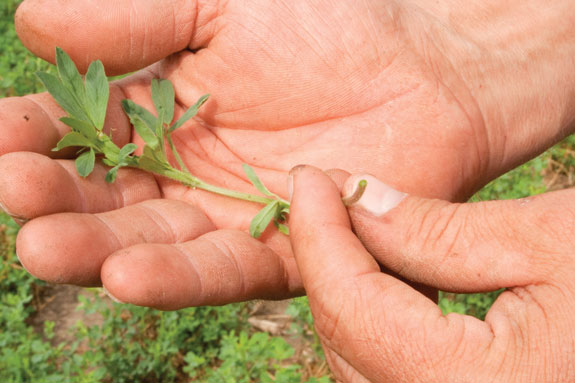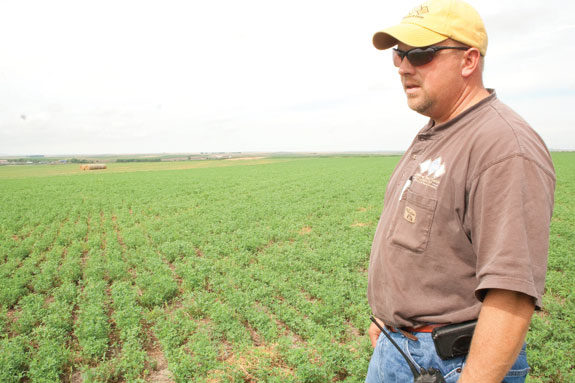Testing revealed 27 percent protein content and 195 RFV (Relative Feed Value) in the harvested alfalfa bales.
The Jorgensens don’t typically market their alfalfa, although a wet growing season has resulted in nearly twice as much alfalfa as they typically harvest. Most of the alfalfa they produce is fed to their own cattle.
Bryan, who manages the family’s cropland, expected to maximize input costs and replicate some of the success he had with the same plant food on his corn and soybean crops. He was pleasantly surprised when he saw re-growth in his alfalfa fields sped up as much as seven days and verified the increased quality of his alfalfa stems through testing.
“We primarily feed the alfalfa we produce to our own cattle,” Jorgensen says. “We raise Black Angus, utilizing a core herd of about 750 registered animals. Out of those cattle we select the best animals for our bull sales and bull leasing program.
What we discovered in our alfalfa fields with a liquid plant food is that re-growth was faster, the leaves were healthier and the stem quality was significantly better.
It’s a foliar application, and we are using the plant food after every cutting. With all the rain this year we’ll have at least three cuttings, maybe four. That’s twice as many as we see in a more normal rainfall pattern. As a result of the excess, we’re selling some of the alfalfa to buyers who are marketing it to dairy farmers.”
Jorgensen says the fertilizer has effectively increased the quality and quantity of all his crops, however even the most effective nutrient won’t provide maximum benefits if soil chemistry isn’t balanced.
“You can’t ignore the soil chemistry in your field,” he says. “The soil, in and of itself has the ability to provide much of the nutrients a plant needs. However, it has to be chemically balanced to do that.
Getting soil to that point, where organic activity is high, can take time. Even with a quality plant food, you won’t obtain the crop quality you want if the soil isn’t built up.”
Jorgensen has studied soil chemistry for the past 15 years and says microbial activity is a primary indicator of soil health. Proper soil chemistry maximizes plant uptake of available soil elements and chemical compounds. Composition and parent material of the soil, soil pH and soil salinity are all key to healthy soil.

“The biological, chemical and physical properties of soil have to be balanced or you won’t be able to consistently produce a high-quality crop,” Jorgensen says.
“In healthy soil you find all types of bacteria and fungi, earthworms and beneficial insects. All these organisms live on soil organic matter or other soil organisms. Their activity is vital to processes in the soil. Among other things, they enhance cycling of nutrients and assist plants in obtaining nutrients from the soil.”
Most organisms are in the top two to three inches of soil layers, where most of the organic matter is. Within those top layers, earthworms and soil animals travel through most parts of the soil.
Soil scientists are just discovering the benefits of microbes in soil and their contribution to soil fertility. Jorgensen says monitoring the health of soil is a key tool in managing any type of product marketing strategy.
“To maximize crop quality you need to feed the soil and the soil then feeds the plant,” Jorgensen says. “It’s a symbiotic relationship. Scientists are learning that improper chemical balance in the soil leads to poor plant nutrient uptake. That uptake can be hindered even further if an application, such as an herbicide, is used and it’s not working in relationship with the soil chemistry.”
Jorgensen notes that standard soil testing doesn’t provide the information producers need to thoroughly assess soil chemical balance.
“You’ll look at a wider range of data and different data than you’ll find on a standard report from a soil testing lab,” he says. “You want to look at the percentage of organic matter, cation exchange capacity (CEC), base saturation, both weak and strong, and Bray phosphorus extraction.
The most important factor is the soil’s ability to move water and oxygen. All of that data will provide information about your soil health.”
Jorgensen has applied a liquid fertilizer on his crops for a number of years. The products have a low salt index, are chloride-free and are virtually non-corrosive to application equipment.
The product can be applied while planting or pre-plant banded to the root zone with bedding equipment. It can be used as a foliar application to supplement soil-supplied nutrients or correct nutrient deficiencies. Jorgensen says for his purposes foliar application to his alfalfa fields after each cutting is most effective in his operation.
“In some alfalfa production systems, fertilizer is applied at the beginning of the growing season and is intended to provide for plant needs throughout the season,” Jorgensen says.
“My thought about that is a significant portion of that application is going to go unused or perhaps erode with wind and rain activity throughout the season. By applying the plant food after each cutting, we’re giving the alfalfa plants a boost when they most need it, when growth is restarted. Because it’s foliar, the product is likely to be absorbed readily through the leaf system.”
Jorgensen utilizes no-till, crop rotation and is beginning to experiment with grazing some crops behind the winter wheat his family raises.
“Soil management strategy has to be a long-term plan,” he says. “Twenty-five years ago, summer fallow was a big part of our crop plan.
We don’t use it at all now because we’ve learned how to make better use of the rainfall we receive here. Rather than focusing on adding nutrients to our soil, we’ve learned how to support the natural biological process and then enhance that with some added nutrients. We’re getting better quality with fewer inputs and we’re applying our inputs in different ways. Managing the soil is the foundation for successful crop production.” FG
Loretta Sorensen is a freelance writer from Yankton, South Dakota
PHOTOS
Bryan Jorgensen (top right) has found that stem quality of his alfalfa has improved since using liquid fertilizer in his fields. He believes that having a good understanding of the soil health also results in a higher-quality crop. Photos courtesy of Loretta Sorensen.











